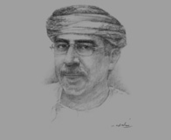OBG talks to Fuad Jaffer Al Sajwani, Minister of Agriculture and Fisheries Wealth

Interview: Fuad Jaffer Al Sajwani
In what way is policy being shaped to boost value-added agriculture and aquaculture manufacturing industries that stimulate economic diversification?
FUAD JAFFER AL SAJWANI: A significant part of Oman’s agricultural and fisheries production, consumed domestically or exported, is in raw form. On the domestic front, there is a need to process this to increase the shelf life of farm products, as well as to reduce post-harvest losses. On the export front, there is a huge opportunity for boosting value added by way of processing fish and agricultural produce. This creates an opportunity for downstream projects, which also generate employment opportunities. The ministry works closely with the Food and Agriculture Organisation on charting the strategic course for its sub-sectors. This has helped in shaping its policies to boost investments in these sectors by way of infrastructure development, investment incentives, adoption of new technologies, training programmes and small business development.
What can the fisheries sector do to leverage free trade agreements (FTAs) with the US and Singapore so as to stimulate foreign investment?
AL SAJWANI: Oman is in a position to leverage these agreements, particularly in aquaculture. Under the FTA, investors from these countries can fully own a business in Oman. Coupled with various incentives offered by the sultanate in the aquaculture sector, such as tax benefits, this repatriation of capital and profits will provide a very good opportunity to tap investors. An FTA with an economic power like the US can provide a good channel to increase Oman’s presence in fisheries industries globally. The Singapore FTA can further open up the existing window to extremely attractive East Asian markets, which are huge consumers of seafood.
How is the government helping the private sector organise and ensure sustainable fishing practices?
AL SAJWANI: The eighth five-year plan provides for OR128m ($333.6m) in funding for various projects in the fisheries segment. These include new and upgraded harbours, ports, cold storage facilities and the like.
These outlays will propel opportunities for the private sector. Other investments in the aquaculture segment are expected to be over OR 100m ($260.6m) during the same period. Most of these are expected to be from international investors, who will work with local partners to bring state-of-the-art technologies and best practices. The process is moving aggressively.
Most of Oman’s fishermen are artisanal and the government is working hard to modernise the fishing fleet, by providing new investment in areas including nets, rods, navigational devices, storage facilities, fish processing facilities, market mechanisms and transport logistics. These are aimed at improving yield and reducing losses in the value chain. While Oman exports nearly half of its fish production, there is also a growing demand to import certain species of fish. Increasing consumption and export demand for Omani fish will create a huge need for increasing farmed fish numbers.
What is your forecast for the future growth of agriculture and fisheries in GDP and employment?
AL SAJWANI: Agriculture and fisheries contributed nearly 1.2% of GDP in the year 2010, of which agriculture made up 0.8% and fisheries 0.5%, with respective annual growth rates of 6.3% and 11.5%. As per government plans, the contribution from the agriculture and fisheries sector is expected to reach 5.1% of GDP by 2020. This growth will mainly come from increased yields, via new technology, improved water utilisation, strengthened marketing channels, and better pest and animal disease control. Employment in agriculture was around 226,000 and in fisheries it was over 50,000, according to 2011 estimates. Considering the ambitious plans for these sectors, they are anticipated to generate significant employment. There are also several rural development programmes, which are expected to create employment for rural youth and women and focus on some new sub-sectors, like aquaculture and dairy.
You have reached the limit of premium articles you can view for free.
Choose from the options below to purchase print or digital editions of our Reports. You can also purchase a website subscription giving you unlimited access to all of our Reports online for 12 months.
If you have already purchased this Report or have a website subscription, please login to continue.

